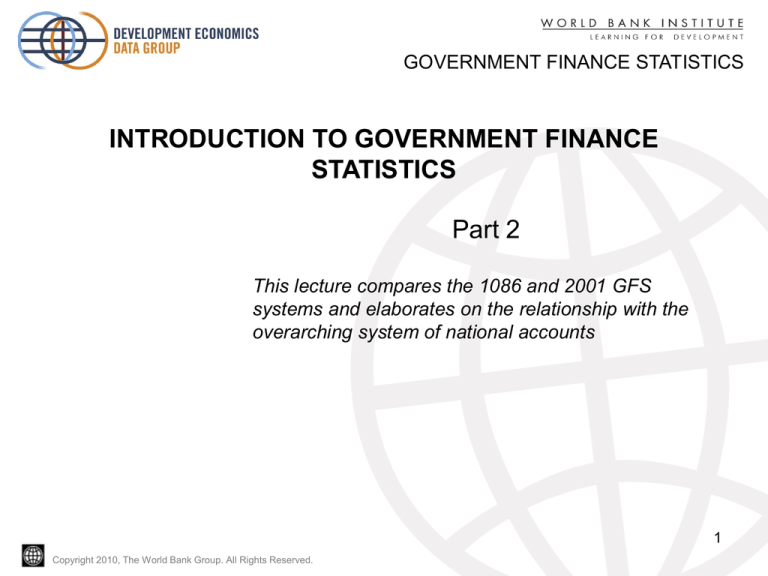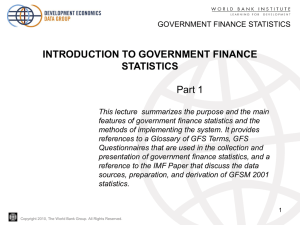
GOVERNMENT FINANCE STATISTICS
INTRODUCTION TO GOVERNMENT FINANCE
STATISTICS
Part 2
This lecture compares the 1086 and 2001 GFS
systems and elaborates on the relationship with the
overarching system of national accounts
1
Copyright 2010, The World Bank Group. All Rights Reserved.
GOVERNMENT FINANCE STATISTICS
1986 and 2001 GFS METHODOLOGIES
• The methodology of the 2001 GFS Manual (GFSM 2001) differs
substantially from that of the 1986 GFS Manual. The main areas of difference
are:
The focus of the coverage of the 2001 GFS Manual is the general
government sector, as defined in the 1993 SNA, and the public
sector,
In the 2001 GFS system, flows are recorded on an accrual basis,
in the 1986 GFS system, transactions are recorded when cash is
received or paid,
In the 2001 GFS system assets, liabilities, and net worth are
valued at current market prices. In the 1986 GFS system debt
securities are valued at the amount the government is obligated to
pay when the debt matures.
2
Copyright 2010, The World Bank Group. All Rights Reserved.
GOVERNMENT FINANCE STATISTICS
COVERAGE OF EVENTS
• The coverage of events in the 2001 GFS system is broader than in the
1986 GFS Manual because the revised system includes all economic events
that affect assets, liabilities, revenue, or expense rather than just those
represented by a cash transaction.
• Consumption of fixed capital is an expense in the 2001 GFS system. As a
noncash transaction, it was excluded from the 1986 GFS Manual.
3
Copyright 2010, The World Bank Group. All Rights Reserved.
GOVERNMENT FINANCE STATISTICS
FLOWS ON A GROSS AND NET BASIS
• Sales and expenses of market establishments are recorded on a gross
basis in the 2001 GFS system.
• Otherwise, the presentation of flows on a gross or net basis is the same
in the 2001 and the 1986 GFS Manuals.
4
Copyright 2010, The World Bank Group. All Rights Reserved.
GOVERNMENT FINANCE STATISTICS
DEFINITIONS AND CLASSIFICATIONS
• Revenue in the 2001 GFS system is an increase in net worth resulting
from a transaction.
• Expense in the 2001 GFS system is a decrease in net worth resulting
from a transaction.
• The classifications of revenue are substantially different in the two
manuals.
• Sales of assets are not revenue in the 2001 GFS Manual and capital
transfers are classified as other revenue.
• The classification of expense by economic type in the 2001 GFS Manual
is broadly similar to the corresponding classification in the 1986 GFS
Manual.
• Lending minus repayments category of transactions in the 1986 GFS
Manual no longer exists.
5
Copyright 2010, The World Bank Group. All Rights Reserved.
GOVERNMENT FINANCE STATISTICS
BALANCING ITEMS FOR FISCAL ANALYSIS
• The GFS system is designed to present data in a format that enables
analysts to compare the operations of governments in a consistent and
systematic manner.
• Comparisons among governments and sectors can be made using
standard classification items and summary balancing items such as:
- net operating balance,
- cash surplus/deficit
- net lending/borrowing,
- change in net worth.
GFS measures of net lending/borrowing and change in net worth can
be directly compared with similar concepts in the 1993 SNA to provide
confirmation of consistency in analysis.
6
Copyright 2010, The World Bank Group. All Rights Reserved.
GOVERNMENT FINANCE STATISTICS
BALANCING ITEMS FOR FISCAL ANALYSIS
• Apart from the core measures of fiscal performance provided by the
balancing items in the core reporting Statements additional balancing
items are defined and can be derived from GFS data.
• The 2001 GFS system provides measures of government performance
that can only be derived using accruals data.
7
Copyright 2010, The World Bank Group. All Rights Reserved.
GOVERNMENT FINANCE STATISTICS
HARMONIZATION WITH THE 1993 SNA
• The harmonization of the GFS system and the 1993 SNA is not complete
for several reasons:
1. the two systems were developed a number of years apart, SNA in 1993
and GFS in 2001,
2. the focus of the GFS system is on financial transactions; taxing,
spending, borrowing, and lending; in the 1993 SNA the emphasis is also
on production and consumption,
3. in some cases, the different focus of statistical measurement in the two
systems requires different definitions of the same data.
• The next slide shows a comparison of the GFSM 2001 and the 1993 SNA
accounting frameworks.
8
Copyright 2010, The World Bank Group. All Rights Reserved.
GFSM 2001
1993 SNA
Transactions
Transactions
Production
account
Revenue
account
Expense
account
Nonfinancial
assets
Income
account
Operating
balance
GDP (value added)
Saving
Capital
transfers &
non-financial
assets
Other
economic
flows
Other
economic
flows
Closing
balance
sheet
Financial
assets &
liabilities
Closing
balance
sheet
Financial
assets &
liabilities
Net lending / borrowing
Copyright 2010, The World Bank Group. All Rights Reserved.
9
GOVERNMENT FINANCE STATISTICS
COMPARISON OF THE STRUCTURES OF GFS AND
SNA SYSTEMS
• The major differences between the 2001 GFS system and the
macroeconomic statistical systems with which it is harmonized are the
classifications used, the accounting statements, and the resulting balancing
items.
• The 2001 GFS analytic framework consists of four statements., each
dealing with financial flows or stocks.
• In the 1993 SNA, transactions are presented in a sequence of seven
accounts, other economic flows are presented in two accounts, and stocks
are presented in the Balance Sheet. There is no SNA equivalent to the GFS
Statement of Sources and Uses of Cash.
10
Copyright 2010, The World Bank Group. All Rights Reserved.
GOVERNMENT FINANCE STATISTICS
COMPARISON OF THE STRUCTURES OF GFS AND
SNA SYSTEMS
• In the SNA, the sequence of transaction accounts is divided into current
and accumulation accounts.
• The current accounts record the production of goods and services and
the generation, distribution, redistribution, and use of income.
• The accumulation accounts record the acquisition and disposal of
assets and liabilities.
11
Copyright 2010, The World Bank Group. All Rights Reserved.
GOVERNMENT FINANCE STATISTICS
COMPARISON OF THE STRUCTURES OF GFS AND
SNA SYSTEMS
• The different treatment of selected activities and placement of
transactions means that balancing items of the two systems produce
different measures.
• For example, GFS balancing item for the first section of the Statement
of Government Operations, the net operating balance, differs from 1993
SNA saving.
• Similarly, net lending/borrowing is the balancing item in both the
Statement of Government Operations and for the Capital and
Financial Accounts of the 1993 SNA.
• In the 1993 SNA, the same distinction between holding gains and other
changes in the volume of assets is made.
• The coverage of the GFS Balance Sheet is identical to the coverage
of the Balance Sheet in the 1993 SNA.
12
Copyright 2010, The World Bank Group. All Rights Reserved.
GOVERNMENT FINANCE STATISTICS
USE OF GFS DATA TO COMPILE THE SNA
• The starting point for compiling statistics for the general government
sector of the SNA are GFS data.
• When a transaction is recorded in a current account of the SNA, it is
classified as a “use” (a reduction in the economic value of the unit) or a
“resource” (an addition to the economic value of a unit).
• When a transaction is recorded in an accumulation account of the SNA, it
is classified as a change in an asset, a change in a liability, or a change in
net worth depending on its effect on the balance sheet.
13
Copyright 2010, The World Bank Group. All Rights Reserved.
GOVERNMENT FINANCE STATISTICS
ACCOUNTING FOR PRODUCTION
• The productive activities of government are recorded quite differently in
the two statistical systems.
• Output is the value of goods and services produced during an accounting
period. It is not recorded as such in the GFS system because most of the
output of general government units is distributed on a nonmarket
basis.
• The total output of the general government sector is determined as the
sum of the output of nonmarket establishments and the output of market
establishments.
• The output of nonmarket establishments is defined to be equal to
the sum of the production costs.
14
Copyright 2010, The World Bank Group. All Rights Reserved.
GOVERNMENT FINANCE STATISTICS
ACCOUNTING FOR PRODUCTION
• Market output is the sum of the entire output of market establishments,
actual sales of nonmarket establishments, and other output that is imputed
to have been sold.
• Intermediate consumption is needed for the SNA production account but
is not a GFS expense category.
• Consumption of fixed capital in the SNA equals the expense category of
the same name in the GFS system plus the amount recorded as a
component of own-account capital formation.
15
Copyright 2010, The World Bank Group. All Rights Reserved.
GOVERNMENT FINANCE STATISTICS
THE GENERATION OF INCOME ACCOUNT
• The Generation of Income Account starts with value added balancing
item from the Production Account and then includes: compensation of
employees, other taxes on production paid, and other subsidies on
production received.
16
Copyright 2010, The World Bank Group. All Rights Reserved.
GOVERNMENT FINANCE STATISTICS
FINAL CONSUMPTION
• Final consumption is a key component of gross domestic product, the
principal balancing item in the national accounts.
• Final consumption expenditure of the general government sector is not
an element of the GFS system.
• The difference between final consumption expenditure and actual final
consumption is social transfers in kind.
• When an existing good is sold, the amount received from its sale is
recorded as negative final consumption expenditure if the acquisition of the
good had been classified as final consumption expenditure.
• Own-account capital formation is part of output but not part of final
consumption expenditure.
17
Copyright 2010, The World Bank Group. All Rights Reserved.
GOVERNMENT FINANCE STATISTICS
SOCIAL INSURANCE
• Social contributions paid by employers as part of compensation of
employees in the GFS system is identical to the same category in the
SNA.
• The amount recorded for social contributions received by units operating
social insurance schemes, however, can be quite different in the two
systems.
• Social insurance schemes are deemed in the SNA to pay property
income attributed to insurance policyholders to the beneficiaries of the
schemes.
• In the 2001 GFS system, the expense category of social benefits is
narrower than that in the 1993 SNA.
18
Copyright 2010, The World Bank Group. All Rights Reserved.
GOVERNMENT FINANCE STATISTICS
OTHER TRANSACTIONS AND OTHER ECONOMIC
FLOWS
• The GFS system includes a detailed classification of taxes based on
common practice in tax administration.
• In the SNA, taxes are classified according to their role in economic
activities as: taxes on production and imports, current taxes on income,
wealth, etc., or capital taxes.
• Several types of GFS property income need to be reclassified in SNA
compilation.
• Reinvested earnings on direct foreign investment is not recorded in the
GFS system; it must be estimated from other sources.
19
Copyright 2010, The World Bank Group. All Rights Reserved.
GOVERNMENT FINANCE STATISTICS
OTHER TRANSACTIONS AND OTHER ECONOMIC
FLOWS
• Other current transfers in the SNA is a disparate collection of entries that
are found in various places in the GFS system.
• Most of the entries in the Capital Account of the SNA can be derived
directly from the corresponding entries in the GFS system.
• Consumption of fixed capital in the SNA is identical to the total value of
consumption of fixed capital recorded in the GFS classification of
transactions in nonfinancial assets.
• GFS system includes a category for strategic stocks that does not appear
in the SNA. Strategic stocks are classified as goods for resale in the SNA.
20
Copyright 2010, The World Bank Group. All Rights Reserved.
GOVERNMENT FINANCE STATISTICS
OTHER TRANSACTIONS AND OTHER ECONOMIC
FLOWS
• Capital transfers in the SNA are recorded in various places in the GFS
system.
• The transactions recorded under insurance technical reserves differ in the
two systems because of the different treatment of employer social
insurance schemes that provide pensions and other retirement benefits.
• Transactions in shares and other equity differ because the SNA includes
reinvested earnings on direct foreign investment as an imputed purchase
of shares and other equity.
• For the most part, other flows are the same in both systems.
21
Copyright 2010, The World Bank Group. All Rights Reserved.
GOVERNMENT FINANCE STATISTICS
REVISION OF THE GFSM 2001
Following the revision of the 1993 SNA and the methodology changes
introduced in the 2008 System of National Accounts (2008 SNA) work is
proceeding on the update of the 2001 GFS Manual.
22
Copyright 2010, The World Bank Group. All Rights Reserved.









